Your heat-treated aquamarine will permanently stay blue because the controlled heating process at 400°C creates irreversible changes to the crystal structure, eliminating greenish tones forever. This industry-standard treatment is stable and won’t fade over time, unlike some other gemstone enhancements. However, you’ll need proper care to maintain the stone’s overall beauty, including gentle cleaning and protective storage away from extreme temperatures. Understanding the complete picture will help you maximize your gem’s longevity and value.
Understanding Heat Treatment in Aquamarine Gemstones
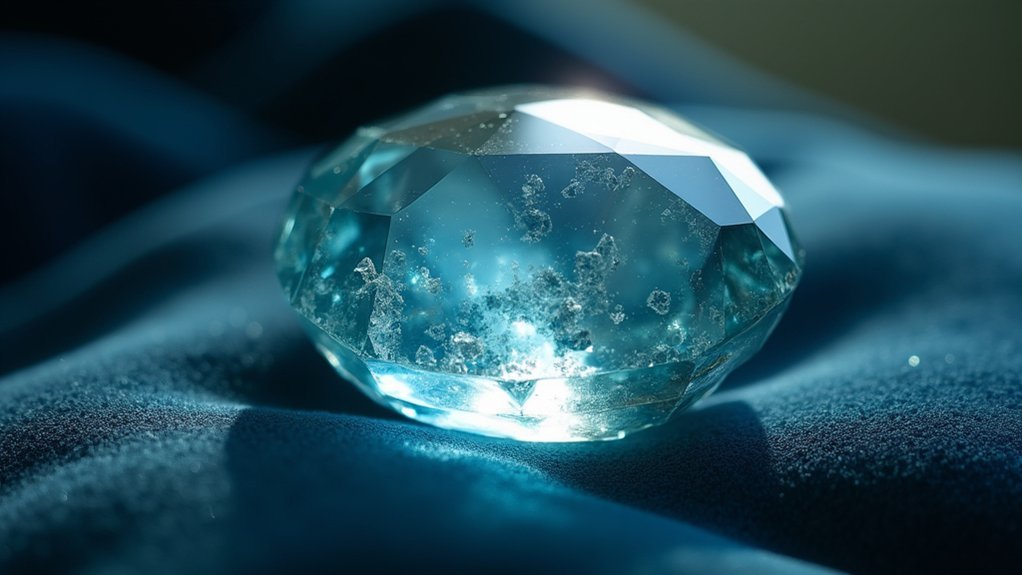
Heat treatment transforms aquamarine gemstones by converting their natural greenish tones into the coveted blue hue that defines this precious stone.
Heat treatment permanently converts aquamarine’s natural green tones into the distinctive blue color that makes this gemstone so highly prized.
You’ll find that most commercially available aquamarines have undergone this process at approximately 400°C. While heat treatment doesn’t affect color saturation, it creates permanent, stable results that the jewelry industry widely accepts.
However, you should understand that not all stones can survive this process. Heat treatment can worsen existing inclusions, potentially causing cracks or flaws.
That’s why unheated natural aquamarines command premium prices and higher market demand among collectors.
The treatment greatly impacts gemstone value, making heated stones more accessible while positioning untreated specimens as rare treasures.
You’ll need expert evaluation to determine treatment history and assess quality.
The Science Behind Aquamarine Color Enhancement
When exposed to controlled temperatures around 400°C, aquamarine’s crystal structure undergoes a fascinating transformation that permanently alters its color properties.
This heat treatment process effectively eliminates greenish tones from your natural aquamarine, converting them into the coveted blue color that’s become the industry standard.
The color enhancement occurs without compromising saturation levels, making your gem visually appealing.
However, you should understand the process involves risks:
- Existing inclusions can expand and create cracks during heating
- Improper temperature control may damage your stone’s integrity
- The treatment permanently changes your gem’s natural characteristics
- Heat-treated stones typically have lower gem value than untreated specimens
While nearly all commercial aquamarines undergo this process, collectors increasingly prize untreated stones for their rarity and authentic greenish-blue hues.
Factors That Affect Heat-Treated Color Stability
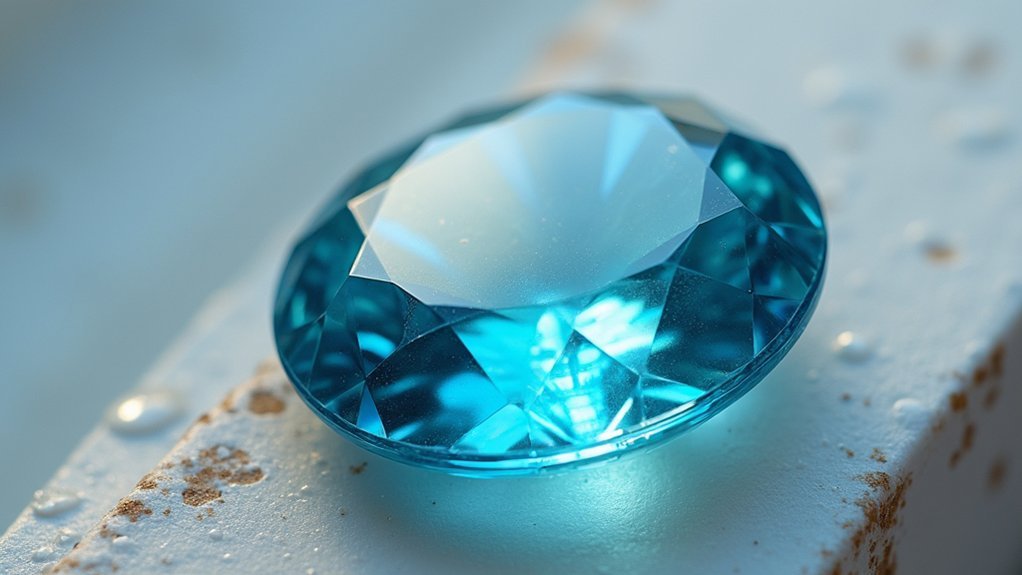
You’ll find that several vital factors determine how well your heat-treated aquamarine maintains its enhanced blue color over time.
Temperature control methods during the initial treatment process directly influence the permanence of color changes, while the iron content in your stone’s chemical composition affects how it responds to heating.
Your aquamarine’s crystal structure stability also plays an essential role in whether the enhanced color remains vibrant or gradually shifts back toward its original appearance.
Temperature Control Methods
Although the transformation from greenish to blue appears straightforward, achieving consistent results in heat-treated aquamarine requires precise temperature control methods that directly impact the stone’s final color stability.
You’ll need to maintain approximately 400°C throughout the process to guarantee your gemstone develops a stable blue color without compromising its structural integrity.
Your success depends on implementing proper control techniques:
- Monitor temperature continuously using calibrated pyrometers to prevent overheating that can crack your aquamarine
- Control heating duration carefully based on your stone’s iron content and origin characteristics
- Use gradual temperature ramping rather than sudden changes to avoid thermal shock
- Implement controlled cooling phases to lock in the enhanced color permanently
Iron Content Impact
The iron content within your aquamarine acts as the primary determinant of color stability following heat treatment, with ferrous iron levels directly controlling both the intensity and longevity of the blue transformation.
When you heat treated aquamarine at 400°C, stones with ideal iron content maintain their blue hue more effectively than those with insufficient levels. Lower iron content can cause your gem’s color stability to deteriorate over time, potentially reverting toward greenish tones.
Your stone’s geographic origins greatly influence these iron concentrations, making source identification essential for predicting gem response.
Additionally, existing inclusions and internal flaws can compromise stability by becoming more pronounced during heating, further affecting your aquamarine’s ability to retain its desired blue coloration permanently.
Crystal Structure Stability
When examining your aquamarine’s hexagonal crystal structure, you’ll find that this fundamental framework determines how successfully your stone withstands the 400°C heat treatment process.
Your gem’s structural integrity directly impacts color stability during enhancement procedures.
The crystal structure’s response to high temperatures varies considerably based on several factors:
- Internal flaws – Inclusions and bubbles can cause cracking when exposed to heat treatment temperatures
- Stone quality – Natural aquamarines with fewer pre-existing structural weaknesses retain better color stability
- Origin matters – Certain sources produce aquamarine with crystal structures that respond more favorably to color enhancement
- Hexagonal stability – Well-formed crystal lattices maintain their integrity better during the transformation from bluish-green to pure blue
Your heat treated aquamarine’s longevity depends on this foundational crystal architecture.
Natural vs. Heat-Treated Aquamarine: Key Differences
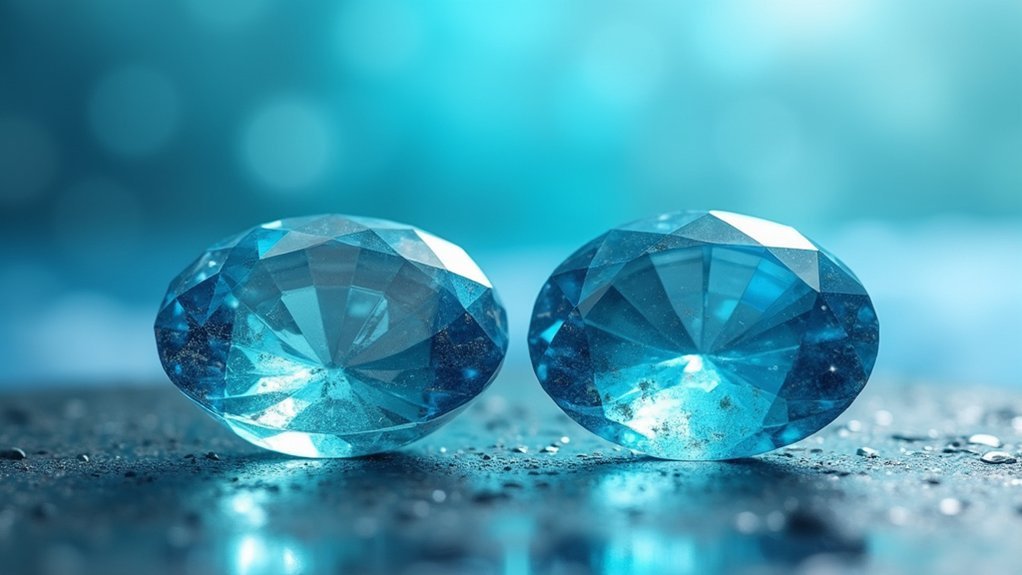
When you’re choosing between natural and heat-treated aquamarine, you’ll notice that heat-treated stones maintain their enhanced blue color permanently, while natural stones retain their original bluish-green hue that won’t change over time.
You’ll find that natural aquamarines command higher prices in today’s market because collectors increasingly value their rarity and untouched qualities.
The treatment process creates a more vivid blue appearance, but it can’t increase the stone’s color saturation—only redistribute the existing color components.
Color Stability Differences
Although natural aquamarine displays inherent color variations that can shift over time, heat-treated stones offer remarkably consistent blue hues that remain stable for decades.
When you’re choosing between these options, understanding color stability becomes essential for your investment.
Heat treated aquamarine maintains its enhanced blue color through a permanent transformation at 400°C, while untreated aquamarine may show unpredictable changes.
The saturation level remains unchanged during treatment, but the gem characteristics become more reliable.
- Heat-treated stones: Provide consistent, vibrant blue coloration that won’t fade
- Untreated aquamarine: Shows natural pale bluish-green tones with potential color variations
- Market preference: Rare natural stones command higher prices despite stability concerns
- Long-term durability: Treated gems offer predictable appearance over time
Market Value Impact
Several factors determine whether you’ll pay premium prices for natural aquamarine or enjoy the affordability of heat-treated alternatives. Untreated aquamarines command higher market value due to their rarity and authentic appeal among collectors who prize natural stones.
While heat treated gems offer vibrant blue color at lower costs, they’re commonly used in commercial jewelry and face declining resale values.
You’ll find that natural options increasingly attract premium pricing as demand grows for unheated specimens. The market perception strongly favors untreated stones, creating competitive advantages for sellers of natural aquamarines.
When considering long-term investment potential, collectors specifically seek natural specimens, making pricing structures favor genuine stones over their enhanced counterparts in today’s evolving marketplace.
How Long Does Heat-Treated Blue Color Last?
How durable is the enhanced blue color in heat-treated aquamarine? You’ll be pleased to know that the permanence of this treatment is exceptional. Unlike many other gemstones, your heat-treated aquamarine will maintain its beautiful blue color for a lifetime without fading under normal conditions.
The heating process creates stable color changes that resist environmental factors like sunlight, temperature variations, and everyday wear.
Heat treatment produces permanent color stability in aquamarine, ensuring your gemstone withstands daily exposure to light, temperature changes, and regular use.
Here’s what makes heat-treated aquamarine so dependable:
- The blue color transformation is permanent and won’t revert to its original greenish hues
- Saturation levels remain consistent throughout the gem’s lifetime
- Normal jewelry cleaning and maintenance won’t affect the enhanced color
- Heat-treated stones perform as reliably as natural blue aquamarines in durability
Your investment in heat-treated aquamarine guarantees lasting beauty.
Environmental Conditions That Cause Color Fading
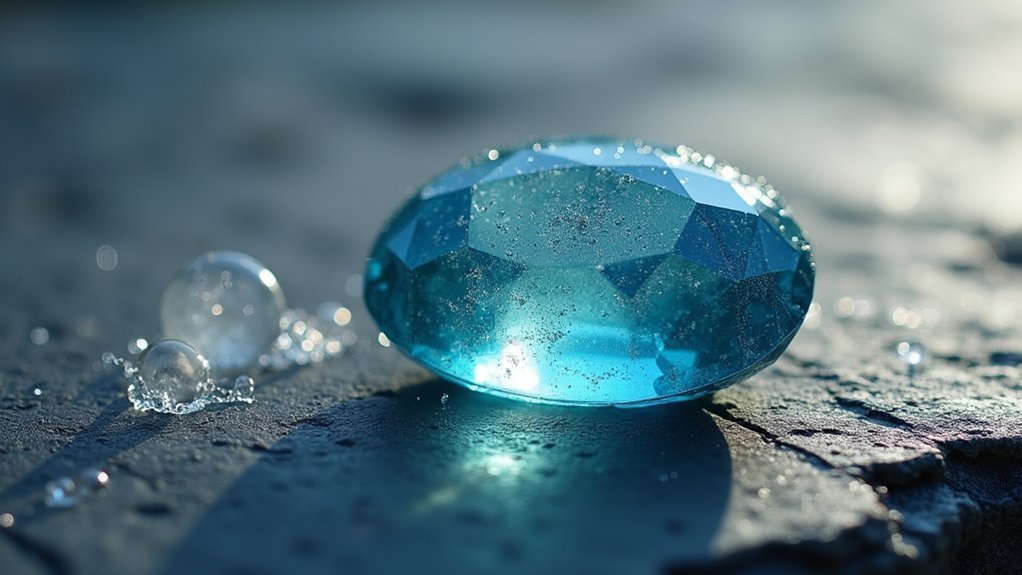
Your heat-treated aquamarine’s vibrant blue color faces three main environmental threats that can cause permanent fading.
UV light exposure from prolonged sunlight breaks down the color-enhancing treatment, while high temperatures can destabilize the gem’s enhanced hue.
Chemical contact from household cleaners, perfumes, or pool water creates surface damage that dulls the stone’s brilliance.
UV Light Exposure
Ultraviolet radiation poses a significant threat to heat-treated aquamarine’s vibrant blue coloration. When you expose your heat-treated aquamarine to UV light, you’ll notice the treatment process has compromised its natural color stability.
The stone’s artificial enhancement makes it more vulnerable than natural unheated aquamarines, which typically resist color fading better.
Your gemstone’s durability depends on several factors:
- Exposure duration – Longer UV exposure accelerates color fading
- Light intensity – Stronger UV radiation causes more dramatic changes
- Treatment quality – Poor heat treatment increases vulnerability
- Stone inclusions – Internal flaws affect overall stability
To protect your investment, minimize direct sunlight exposure and store your aquamarine in UV-protected environments.
Understanding these vulnerabilities helps you preserve your gemstone’s beauty.
High Temperature Effects
While heat-treated aquamarine demonstrates remarkable color stability under normal conditions, excessive temperatures can compromise its enhanced blue appearance. Your gemstone’s blue color remains stable until exposure to extreme heat exceeding 400°C, where significant color fading becomes possible.
High temperatures can trigger structural changes within the crystal, potentially reversing the enhancement process that created the desired hue.
You’ll need to protect your heat-treated aquamarine from prolonged exposure to intense heat sources like direct flames, jewelry torches, or industrial heating equipment. Even extended exposure to lower temperatures can gradually affect durability over time.
Proper care involves storing your gemstone away from heat sources and avoiding situations where temperature fluctuations occur rapidly. This preventive approach guarantees your aquamarine maintains its vibrant appearance for years.
Chemical Contact Damage
Although heat-treated aquamarine displays enhanced durability, chemical exposure poses a significant threat to its vibrant blue coloration.
Your gemstone’s color fading can occur when it encounters various household cleaners, perfumes, and other harsh chemicals. These substances can compromise the stone’s color integrity, causing noticeable dulling over time.
Environmental factors also accelerate chemical contact damage:
- Avoid household cleaners – Ammonia-based products and bleach can permanently alter your stone’s appearance
- Limit sunlight exposure – Prolonged UV rays combined with chemical residues intensify color deterioration
- Remove jewelry during cleaning – Protect your heat-treated aquamarine from accidental chemical splashes
- Store properly – Keep away from cosmetics and cleaning supplies to prevent vapor exposure
Preventing chemical contact damage guarantees your aquamarine maintains its stunning blue hue for years.
Proper Storage Methods for Heat-Treated Aquamarine
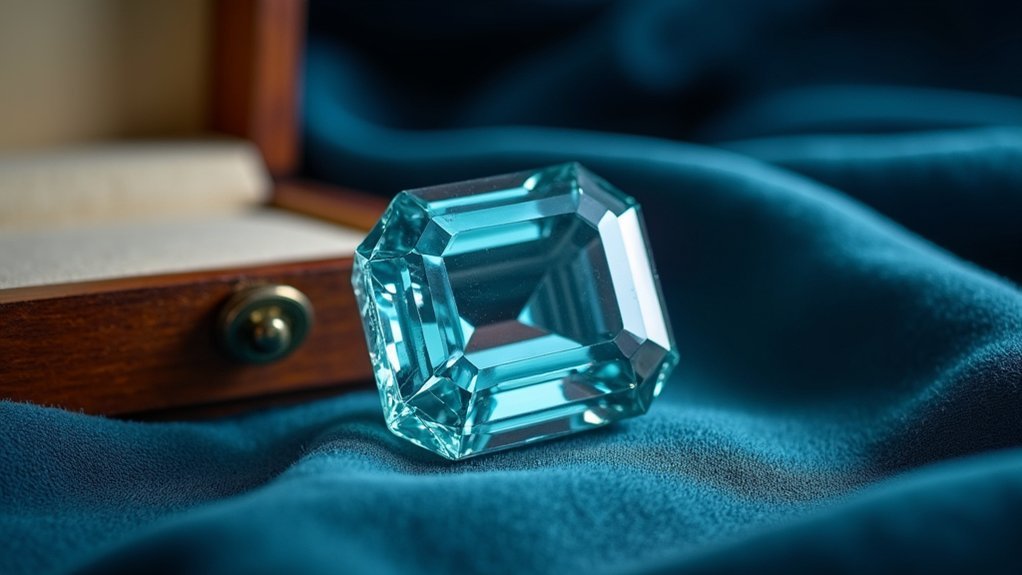
Since heat-treated aquamarine retains its beauty through careful handling, you’ll want to store these gemstones in soft cloth pouches or individual jewelry compartments to prevent scratches from harder materials.
These storage methods protect against damage from other gemstones or sharp objects that could chip your stone, given its 7.5-8 hardness rating.
Keep your heat-treated aquamarine away from extreme temperatures and direct sunlight to maintain temperature stability and preserve its enhanced blue color.
Don’t store it with heavy items that could cause breaks or chips.
Perform regular inspection for existing flaws that improper storage might worsen.
Before storing, complete proper cleaning using warm soapy water and gentle brushing, then thoroughly dry with soft cloth to prevent moisture buildup that could compromise your gemstone’s condition.
Care and Maintenance Best Practices
Beyond proper storage techniques, maintaining your heat-treated aquamarine’s brilliance requires consistent care routines that protect both its enhanced color and structural integrity.
Your stone should be cleaned regularly using warm soapy water and a soft brush to preserve its clarity without causing damage. Store aquamarine jewelry in protective pouches between wears, and avoid extreme temperatures that could compromise the treatment’s stability.
- Clean weekly with gentle dish soap, warm water, and a soft-bristled toothbrush
- Remove jewelry before sports, manual labor, or activities causing physical stress
- Inspect for signs of damage monthly, checking for chips, cracks, or loose settings
- Consult a professional gemologist annually for deep cleaning and professional assessment
Regular maintenance guarantees your heat-treated aquamarine maintains its enhanced blue color while preventing costly repairs from neglect.
Market Value Considerations for Treated Stones
When you’re considering the investment potential of heat-treated aquamarine, understanding market dynamics becomes essential for making informed purchasing decisions.
The market value of heat treated stones often disappoints sellers, as pricing for rough treated and untreated aquamarine remains surprisingly similar. You’ll find that untreated stones command premium prices due to their increasing rarity and growing consumer demand for natural specimens.
If you’re selling heat-treated aquamarine, you’ll face stiff competition from commercial sellers who flood the market with blue-enhanced stones.
The permanent color alterations don’t translate into proportional value increases, limiting economic viability. Savvy buyers increasingly seek distinctive, untreated options, making it challenging to achieve expected profits from treated stones despite their enhanced appearance.
Protecting Your Investment: Professional Recommendations
Given the complex market realities surrounding heat-treated aquamarine, you’ll want to implement specific strategies to safeguard your investment and maximize long-term value.
First, consult with a gemologist before purchasing to verify treatment status and quality. Since most commercial aquamarines undergo heat treatment, you’ll need documentation confirming whether your stone is untreated if that’s your preference.
- Purchase exclusively from reputable dealers who provide thorough documentation about treatment history and gemstone authenticity.
- Establish a professional care routine using gentle cleaning methods with warm, soapy water and soft cloths.
- Store your aquamarine separately from harder gemstones to prevent scratching and maintain structural integrity.
- Schedule periodic evaluations with certified gemologists to monitor your investment’s condition and current market value.
These proactive measures protect both your financial investment and the gemstone’s long-term beauty.
Frequently Asked Questions
What Happens When You Heat Aquamarine?
When you heat aquamarine at 400°C, you’ll transform its greenish color to stable blue, permanently enhancing its value. However, you’re risking cracks if your stone has flaws or isn’t properly assessed first.
Why Is My Aquamarine Not Blue?
Your aquamarine isn’t blue because it’s likely unheated, displaying natural pale bluish-green colors. Heat treatment at 400°C removes green hues, enhancing blue appearance. Inclusions or fading from light exposure can also affect coloration.
Does Aquamarine Change Color Over Time?
Your aquamarine won’t change color over time. Once it’s heat-treated, the blue color remains stable permanently. You don’t need to worry about fading from light exposure or environmental conditions affecting your gem’s appearance.
How to Make Aquamarine More Blue?
You can make aquamarine more blue through heat treatment at around 400°C, which removes greenish tones. However, you’ll need professional expertise since improper heating can crack the stone or worsen existing flaws.
In Summary
You’ll find that heat-treated aquamarine’s blue color remains remarkably stable when you store and care for it properly. Don’t expose your gem to extreme temperatures or harsh chemicals, and you’ll preserve its enhanced beauty for decades. While treated stones carry different market values than natural ones, they’re still stunning investments when you understand what you’re purchasing. Follow professional care guidelines, and your heat-treated aquamarine will maintain its enchanting blue hue indefinitely.

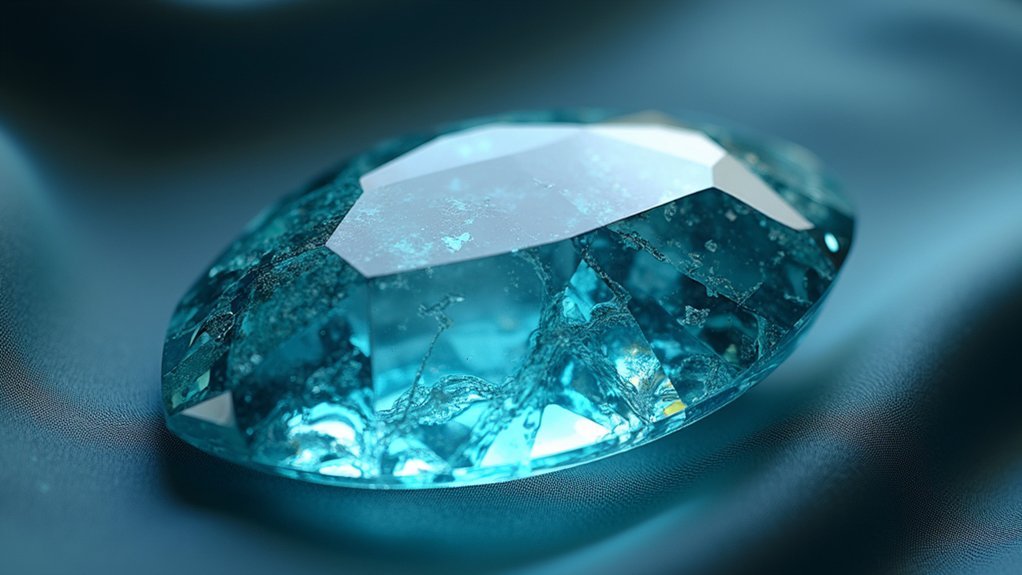



Leave a Reply